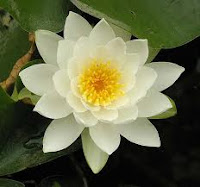FRAGRANT WATER LILY, NYMPHAEA ODORATA
The fragrant water lily or Beaver root, is native to North and Central America , and also Cuba . Another indigenous American water lily is Nelumbo lutea the American lotus. However, this white, fragrant water lily is an invasive weed in Washington State U.S. but it has been used in traditional medicine by Native Americans for centuries.
It is a member of the Nymphaceae family of plants, and lives in slow-moving streams and rivers, as well as in ponds, lakes, marshes, in ditches and canals. It comes into flower during the months of July and August, with its seeds ripening between August and October. It is grown by many people with water gardens as it has a wonderful fragrance, although the flower only opens in the morning; it closes in the afternoon.
Almost all parts of the fragrant water lily plant are edible; the young flower buds can be pickled or cooked in a similar way to the flower buds of the kachnar or Mountain orchid tree. The leaves may be eaten either raw or cooked and can be added to soups and stews. The root can be boiled or roasted while the ripe seeds can be cooked and eaten, or ground into flour. The young flowers are also edible and make wonderful garnishes.
The root and leaves are the main parts of the plant used in medicine. A tisane made from the roots has been used to treat T.B. and chronic bronchial complaints, but has to be taken over a prolonged period of time, and there are some health concerns regarding the prolonged use of the root. The root has antiseptic and astringent properties, probably because of the presence of gallic and tannic acids. The tannins and gallic acid would explain why the root was used for diarrhoea, dysentery, to stop bleeding, for inflammation and gastro-intestinal problems. It was also used as a remedy for gonorrhoea and vaginal discharge.
 A hot poultice of the roots was used on swellings and tumours, as well as on inflamed skin. It is best to harvest the roots after the plant has died back, and these may be dried for later use.
A hot poultice of the roots was used on swellings and tumours, as well as on inflamed skin. It is best to harvest the roots after the plant has died back, and these may be dried for later use. There have been a few studies conducted on this plant, as it is also used in the Ayurveda system of medicine in the Indian subcontinent. It is used traditionally there to get rid of stones in the bodily organs. One study, by Ramesh S. Deoda et al. “Antilithiatic Activity of Leaves, Bulb and Stem of Nymphaea odoratata and Dolichos lablab Beans” in the Research Journal of Pharmaceutical, Biological and Chemical Sciences, Vol. 3 (1) Jan- March 2012, concludes that the leaves and bulbs of the fragrant water lily have good antilithiatic activity.
Another study in the International Journal of Pharmacy and Pharmaceutical Sciences March 2012, Vol.4 (2) suggests that the “leaf extract possesses promising antidiabetic effects”.
Trials have also been conducted on the use of the fragrant water lily extracts n cosmetics. Clearly more research needs to be done to discover how the plant can benefit our health.





